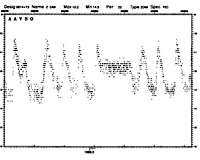 |
 |
The AAVSO worked with the Astro-1 mission in December, 1990, to help observe Z Cam in the UV spectrum. It was observed again on Astro-2 (pictured right), four years later. The results questioned our understanding of Z Cam stars.
A Look at Z CAM
Z Cam is one of the most popular stars in the AAVSO observing program with over 50,000 submitted observations since 1963! It is the prototype star of a subclass of dwarf nova-type cataclysmic variables. The Z Camelopardalis stars are especially known for their random standstills. In The Astronomical Journal (115:1175-1189, 1998 March), a paper titled "An Analysis of AAVSO Observations of Z Camelopardalis" was published by Benjamin D. Oppenheimer, Scott J. Kenyon, and Janet A. Mattei. The abstract of the paper says it all:
We classify outbursts into three main categories - common, plateau, and anomalous - based on the shape and duration of the outburst. Plateau outbursts are brighter and last longer than common outbursts. Some outbursts end in standstills in which the brightness stays constant roughly 1 mag below maximum light for a few days to 1,000 days. The average energy output in a standstill is larger than that during an outburst cycle. All outbursts follow a pattern, the plateau outburst cycle, in which one or more common or anomalous outbursts occur between two plateau outbursts or a plateau outburst and a standstill. Short quiescent durations lead to a higher outburst frequency and more energetic outbursts in intervals dominated by standstills than in other lightcurve intervals.
Our physical picture for Z Camelopardalis stars follows the standard disk instability mechanism for dwarf novae. The plateau outburst cycle is a series of minor, common "inside out" outbursts that lead to a major, plateau outburst that empties the accretion disk. Standstills occur when the mass transfer rate from the secondary star into the accretion disk surrounding the primary star is too large to produce dwarf nova outbursts. The system resembles a nova-like variable during standstill; it returns to the plateau outburst cycle when the mass transfer rate declines below some critical level. Our analysis suggests that irradiation of the secondary does not play a significant role in the evolution of M. Solar-type magnetic cycles are a more plausible mechanism.

(click thumbnail for close up)
To see more AAVSO observations of Z Cam, please visit our light curve generator page
UV Doubts
During the Astro-1 mission on board the space shuttle Columbia in December 1990, the AAVSO helped monitor 10 dwarf nova-type cataclysmic variables (see Sky & Telescope for June 1991, page 591, for a very interesting and exciting article by Stephen Maran). Of these, Z Cam was chosen as a target for the Hopkins Ultraviolet Telescope (HUT), which was part of Astro-1. Z Cam was chosen as a target because, when it went into outburst during the mission, AAVSO observers promptly alerted AAVSO Headquarters, who in turn alerted the Astro-1 astronomers to the outburst. Immediately, the results of the spectrum analysis (a sample of which is below) cast doubt on then-current understanding of Z Cam stars. In "Far-Ultraviolet Astronomy on the Astro-1 Space Shuttle Mission", Mary Romelfanger said, "The observations provide the first detailed look at the far-UV spectral region of such an outburst. Attempts to model the spectrum with standard accretion disk theory met with limited success and clearly revealed the need for more detailed theoretical calculations of the expected emission."
The HUT flew once again, four years later on the Astro-2 mission, and again Z Cam was observed. The two sets of observations were compared in the paper "Disks, Winds, and Veiling Curtains: Dissecting the Ultraviolet Spectrum of the Dwarf Nova Z Camelopardalis in Outburst" (C. Knigge, S.K. Long, W.P. Blair, R.A. Wade Astrophysical Journal, v.476, p.291, 1997). Below is an excerpt from the abstract:
"...the predicted spectrum is somewhat too blue at longer wavelengths, causing it to underpredict the flux longward of about 1500 A... This suggests either that our modeling of the standard accretion disk picture is too simplistic - the effects of radial interactions and disk irradiation, for example, have been ignored - or that the standard picture itself may require modification."

Z Cam is a northern circumpolar variable star, favorably placed in the sky at this time of year. It is located near the border of the constellation of Ursa Major. Z Cam should be observed every clear night. Observers with moderate or large telescopes (apertures of 4-10 or more inches) are invited to give it a try!
For More Information
- Disks, Winds, and Veiling Curtains: Dissecting the Ultraviolet Spectrum of the Dwarf Nova Z Camelopardalis in Outburst (Abstract)
- Why Observe Z Cam Stars
- Far-Ultraviolet Astronomy on the Astro-1 Space Shuttle Mission
- AAVSO Monograph 6: Z Camelopardalis Light Curves 1927-1995
- AAVSO charts for Z CAM
This month's Variable Star of the Month was prepared by Aaron Price.

